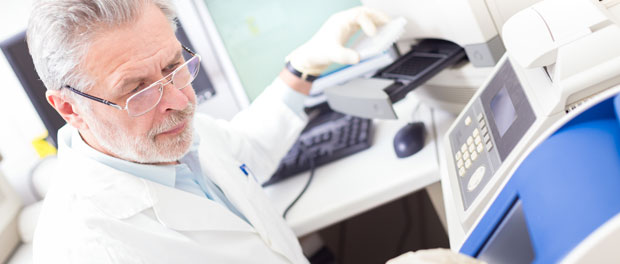
Editor’s Note: At the author’s request on August 20th, 2015, revisions to this article were made following careful consideration. All changes are denoted in red.
In the previous post of this ChIP series, we left off with your samples rotating at four degrees overnight, to give the antibodies plenty of time to bind and the beads plenty of time to block. In this final post, we will finish the assay and provide advice on how to QC and analyze your libraries.
Binding and Washing
Following the overnight incubation, add 30 uL worth of beads to each IP. Although it is not always necessary to remove the blocking solution, I recommend precipitating the beads, removing the BSA/tRNA solution, and resuspending the blocked beads in a convenient volume of dilution buffer. Then add the resuspended beads to your IPs and incubate for four hours at four degrees with gentle agitation.
Before the four hour incubation is over, prechill all your wash buffers- TSE I, TSE II, TSE III, and TE pH 8.0. Perform the washes on ice with the chilled buffers sequentially. First, precipitate the beads from the IP, remove the supernatant, and add 800 uL TSE I. Resuspend the beads in TSE I by gently shaking the tube, not by pipetting up and down. Spin them down briefly to bring down any solution stuck to the cap, and incubate them on ice for 15 minutes. (The 15 minute incubations are a pain, but they are worth it, as they make the washes more effective.) Then repeat this process for TSE II and III.
After removing TSE III, wash once with 1 mL of TE. This time it is not necessary to incubate on ice- the TE wash just gets rid of whatever residual chemicals are left over from the TSE washes. In removing the TE wash, you may want to use a P20 pipet to remove every last bit of wash from the tubes. Just be careful that you don’t at any point let the beads dry out.
To elute your libraries, prepare a fresh stock of elution buffer- 200 uL buffer plus 1 uL proteinase K for each IP. Add 100 uL elution buffer to each tube, gently resuspending the beads by shaking, and incubating them at 55 degrees for 15 minutes. Remove and store this 100 uL of eluate, then add a new 100 uL elution buffer + prot K to each tube and perform a second elution. Pool the two eluates and incubate them and the total inputs at 65 degrees for eight hours.
As a trivial point, I usually do not program a four degree hold at the end of my thermocycler’s decrosslinking program. This is because the elution buffer has a tendency to freeze at four degrees, and the extra freeze-thaw may damage the DNA more than just letting the libraries sit at room temperature. Again, this shouldn’t be a big deal.
Cleaning Up and QCing Your Libraries
After decrosslinking, I add 1 uL RNase to each sample and incubate at 37 degrees for 30 minutes. Then I add 1 uL proteinase K and incubate at 55 degrees for 30 minutes. In theory, neither of these steps are necessary, but I like to be sure that all of the protein and RNA is chewed up before doing a column cleanup.
We use the QIAgen PCR Purification Kit to clean up our libraries. Remember to add 10 uL of sodium acetate per 1 mL of PB binding buffer, because otherwise the pH of the elution buffer may inhibit the DNA’s binding to the column. Elute in 50-100 uL water.
Boom! You are done. At this point, I always run out an aliquot of my total input on the Bioanalyzer, to make sure that the shearing is OK. If you are preparing your samples for Chromatin Immunoprecipitation sequencing (ChIP-seq), I strongly recommend running at least a few RT-PCRs to make sure that your libraries are up to snuff. Which brings me to the final point…
Real-Timing Your ChIP Libraries
Whether RT-PCR is your readout for a ChIP experiment or merely a QC step before ChIP-seq, it’s worth doing right. Like many other aspects of ChIP, real time PCR on ChIP samples can be finicky and frustrating. If possible, try to be ready with primers for positive and negative control regions. Positive control regions (where you know your target should be binding) may be found in the literature; negative control regions (where you know your target shouldn’t bind) can be picked out of gene deserts in the USCS Genome Browser, regions in the middle of nowhere that shouldn’t have any transcription factors or DNA binding proteins associated with them. Here are some of the primers we use as negative control regions:
| Forward | Reverse | Genomic Coordinates (hg19) | Size (bp) | |
| Neg Ctrl 1 | GGGGGATCAG ATGACAGTAAA |
AATGCCAGCA TGGGAAATA |
chr21:25509072+25509220 |
149 |
| Neg Ctrl 2 | GGGAAAGTCC AGGGGAATAA |
GGAGACCCCA ATACAATAACG |
chr8:78934960+78935092 |
133 |
| Neg Ctrl 3 | TGAACTTTGG GGAGAATGAAA |
ACAAGAGTGA TGGTCAATGTCTT |
chr8:111624471+111624620 |
150 |
Of course, before burning precious library on untested primers, we recommend running a real time PCR on genomic DNA to make sure they work nicely and generate solid melt curves.
I get edgy when having to QC ultra-important ChIP libraries, so usually I will take an aliquot (about 15 uL of an 80 uL eluate) of each tube after elution from the column, then dilute that in water to a suitable volume for RT-PCR. Be careful not to dilute it to too much. Even if your library is good, you will not be able to get reliable results by RT-PCR if you dilute it too far. Usually I dilute the 15 uL aliquot with 30 uL water, then use 3 ul of this per well for one positive and one negative control region (in duplicate). This limited run should tell you if these libraries are worth pursuing or not.
It’s important to be mindful of your sonication profiles for RT-PCR. Remember that if you sonicated your DNA to an average fragment of about 150 bp, it may be very difficult to amplify using primers for a 100 bp amplicon (simply because very few complete copes of that amplicon will be intact). Conversely, if you have lots of high MW fragments, those can bias your results too, because with each 1 kb fragment you will have pulled down not only the region to which your target binds, but also 900 bp of the DNA flanking it.
DNA from ChIP can be challenging to analyze by RT-PCR. For one thing, this DNA has already been through a lot- fixation, sonication, two days of manipulation, decrosslinking… Some of the DNA you pulled down will likely be damaged, incapable of amplification by PCR. Plus, your final ChIP library may well be a few hundred picograms of DNA, of which you are running a very small aliquot. When you are dealing with extremely small quantities of damaged DNA, not every well of an RT-PCR will turn out the same.
If ChIP-seq is your endpoint, RT-PCR should be your last QC before preparing your libraries for next gen sequencing. It’s often the case that not every control you run will look perfect- don’t panic! You just generally want to make sure that you pulled down something real and won’t waste a huge amount of time and money on sequencing a ChIP that flat-out didn’t work. We’ve had a few libraries that looked so-so by RT-PCR, but when we sequenced them on the Illumina, they still gave reasonable results. Of course, we’ve also had one or two libraries that didn’t look so great by RT-PCR and still didn’t look so great by NGS, so to some extent, it’s a judgment call based on how confident you are of your results.
If RT-PCR is your endpoint, it’s worth taking a few extra steps to ensure you are getting the highest-possible quality data. First, use clean, filtered tips- nothing that has been sitting out for months. In a very sensitive assay, old tips can actually make a difference. Second, use a good real time polymerase mix. We use the Biorad iQ SYBR Green Supermix. Some mixes, especially the fast-cycling ones, are very sloppy and have trouble with challenging amplicons (for instance, longer amplicons or ones with high GC content). Biorad’s iTaq Universal SYBR Green Mastermix is supposed to have even greater efficiency for challenging amplicons, although we’ve never had need to use it. Lastly, run your assays in triplicate. Three replicates will help minimize wonky results and keep p values low for publication.
Concluding Remarks
ChIP is a tremendously challenging assay, but one that is tremendously valuable once mastered. The keys to successful ChIP- and to success in molecular biology in general, really- are:
- Do your homework
- Plan every aspect of the experiment beforehand
- Don’t cut corners
- Include positive and negative controls
- Don’t be cheap, use high-quality reagents
Once you get a ChIP assay working robustly, it is virtually a guaranteed publication, especially if you are characterizing a previously unknown DNA binding protein. A good ChIP-seq dataset is often more than enough to base a PhD around, and there are many different directions you can take with your project once you have that data.
I hope this walk-through has been helpful for you. Being that I am still learning the finer points of ChIP myself, I welcome any comments or questions, which can be posted below or addressed to [email protected].
Review the first two parts to the series A Technical Guide to Conquering ChIP:
- Part I: Preparation for Chromatin Immunoprecipitation (ChIP)
- Part II: A Starter Chromatin Immunoprecipitation (ChIP) Protocol


